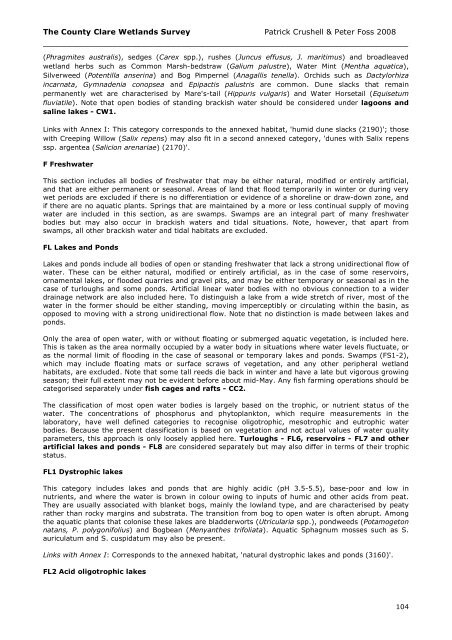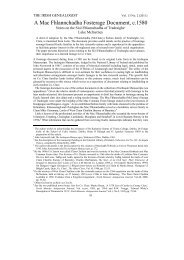Report Cover Vol I - Clare County Library
Report Cover Vol I - Clare County Library
Report Cover Vol I - Clare County Library
You also want an ePaper? Increase the reach of your titles
YUMPU automatically turns print PDFs into web optimized ePapers that Google loves.
The <strong>County</strong> <strong>Clare</strong> Wetlands Survey Patrick Crushell & Peter Foss 2008<br />
_______________________________________________________________<br />
(Phragmites australis), sedges (Carex spp.), rushes (Juncus effusus, J. maritimus) and broadleaved<br />
wetland herbs such as Common Marsh-bedstraw (Galium palustre), Water Mint (Mentha aquatica),<br />
Silverweed (Potentilla anserina) and Bog Pimpernel (Anagallis tenella). Orchids such as Dactylorhiza<br />
incarnata, Gymnadenia conopsea and Epipactis palustris are common. Dune slacks that remain<br />
permanently wet are characterised by Mare's-tail (Hippuris vulgaris) and Water Horsetail (Equisetum<br />
fluviatile). Note that open bodies of standing brackish water should be considered under lagoons and<br />
saline lakes - CW1.<br />
Links with Annex I: This category corresponds to the annexed habitat, 'humid dune slacks (2190)'; those<br />
with Creeping Willow (Salix repens) may also fit in a second annexed category, 'dunes with Salix repens<br />
ssp. argentea (Salicion arenariae) (2170)'.<br />
F Freshwater<br />
This section includes all bodies of freshwater that may be either natural, modified or entirely artificial,<br />
and that are either permanent or seasonal. Areas of land that flood temporarily in winter or during very<br />
wet periods are excluded if there is no differentiation or evidence of a shoreline or draw-down zone, and<br />
if there are no aquatic plants. Springs that are maintained by a more or less continual supply of moving<br />
water are included in this section, as are swamps. Swamps are an integral part of many freshwater<br />
bodies but may also occur in brackish waters and tidal situations. Note, however, that apart from<br />
swamps, all other brackish water and tidal habitats are excluded.<br />
FL Lakes and Ponds<br />
Lakes and ponds include all bodies of open or standing freshwater that lack a strong unidirectional flow of<br />
water. These can be either natural, modified or entirely artificial, as in the case of some reservoirs,<br />
ornamental lakes, or flooded quarries and gravel pits, and may be either temporary or seasonal as in the<br />
case of turloughs and some ponds. Artificial linear water bodies with no obvious connection to a wider<br />
drainage network are also included here. To distinguish a lake from a wide stretch of river, most of the<br />
water in the former should be either standing, moving imperceptibly or circulating within the basin, as<br />
opposed to moving with a strong unidirectional flow. Note that no distinction is made between lakes and<br />
ponds.<br />
Only the area of open water, with or without floating or submerged aquatic vegetation, is included here.<br />
This is taken as the area normally occupied by a water body in situations where water levels fluctuate, or<br />
as the normal limit of flooding in the case of seasonal or temporary lakes and ponds. Swamps (FS1-2),<br />
which may include floating mats or surface scraws of vegetation, and any other peripheral wetland<br />
habitats, are excluded. Note that some tall reeds die back in winter and have a late but vigorous growing<br />
season; their full extent may not be evident before about mid-May. Any fish farming operations should be<br />
categorised separately under fish cages and rafts - CC2.<br />
The classification of most open water bodies is largely based on the trophic, or nutrient status of the<br />
water. The concentrations of phosphorus and phytoplankton, which require measurements in the<br />
laboratory, have well defined categories to recognise oligotrophic, mesotrophic and eutrophic water<br />
bodies. Because the present classification is based on vegetation and not actual values of water quality<br />
parameters, this approach is only loosely applied here. Turloughs - FL6, reservoirs - FL7 and other<br />
artificial lakes and ponds - FL8 are considered separately but may also differ in terms of their trophic<br />
status.<br />
FL1 Dystrophic lakes<br />
This category includes lakes and ponds that are highly acidic (pH 3.5-5.5), base-poor and low in<br />
nutrients, and where the water is brown in colour owing to inputs of humic and other acids from peat.<br />
They are usually associated with blanket bogs, mainly the lowland type, and are characterised by peaty<br />
rather than rocky margins and substrata. The transition from bog to open water is often abrupt. Among<br />
the aquatic plants that colonise these lakes are bladderworts (Utricularia spp.), pondweeds (Potamogeton<br />
natans, P. polygonifolius) and Bogbean (Menyanthes trifoliata). Aquatic Sphagnum mosses such as S.<br />
auriculatum and S. cuspidatum may also be present.<br />
Links with Annex I: Corresponds to the annexed habitat, 'natural dystrophic lakes and ponds (3160)'.<br />
FL2 Acid oligotrophic lakes<br />
104
















